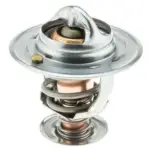Engines need valves to supply fresh air and fuel to the cylinders, and to remove exhaust fumes after combustion. These valves need to be opened and closed at precise times so that the engine functions properly. A failing valve spring will have a direct impact on your car or trucks drive-ability and performance. While valve springs are difficult to access, they are cheap to replace. Check out these valve springs if you’re in need of replacement parts. Before we go into the symptoms of a failing valve spring, let’s first cover how an engine’s valves work.

How Valves Work
An engine has intake and exhaust valves. Car and truck engines run on a four stroke cycle: intake, compression, combustion, and exhaust. In order for the engine to intake air and fuel into the cylinder the intake valves will have to open. After the compression and combustion strokes, the exhaust valves will open via the camshaft. In an overhead cam engine, these valves are opened by the rotating lobes on the camshaft. The Engine Control Module (ECM) synchronizes the camshaft’s rotation the to crankshaft’s rotation. The crankshaft is connected to the pistons in the cylinder where the combustion happens.

The camshaft will open the valves for a set amount of time during its rotation. When the camshaft lobe opens the valve, air and fuel will rush into the cylinder. The exhaust valve functions the same way, but when it opens exhaust fumes will exit the engine’s cylinder. The intake and exhaust valves both utilize a spring to close the valve. Each valve has its on spring. As the camshaft lobe presses the valve down and open, the valve spring will compress exerting a force to close the valve. Once the camshaft lobe has stopped pushing the valve open, the spring force will move the valve upwards and cause it to close.
The spring is absolutely essential to a proper functioning engine. A faulty spring can leave valves open for too long which can cause all sorts of problems. Now that we have a brief background on valves, let’s look at some of the symptoms of a bad valve spring.
Loss of Power at High RPM
Engines operate at high speeds, rotating from 600-800 rpm at idle all the way up to 6,000 rpm or more. At high rpm, the camshaft will be rotating at approximately half the rpm of the crankshaft. The valves will be opening up to 40 times a second! These high rpm can be a problem for engines with weak valve springs. If the valve springs do not close the valves before the next combustion cycle, the cylinders could lose compression and even causing a misfire. This failure is called valve float. Valve float is basically what happens when the valves can’t keep up with the engine’s speeds.
Valve float is most noticeable at high rpm. If your engine has valve float you will notice a power drop off at high rpm. In severe cases of valve float, the engine will make sputtering noise at high speeds. High speed power drop offs can also be symptom of a failing fuel pump. Valve spring failures happen without much warning. Most failures occur due to fatigue from high mileage or spring material defects.
Loss of Power at All Engine Speeds
While a weak valve spring will cause issues at high speeds, a broken valve spring will cause issues at all speeds. A broken valve is not just bad for engine performance, it can also cause severe engine damage leading to costly repairs. Weak valve springs could cause the valve to be opened while the piston is moving up the cylinder for the compression stroke. In some cases, the piston can even contact the valve. This contact can bend or even deform the valve. In some cases the piston can even crack.
How Long do Valve Springs Last
Valve springs can last a long time, but they do wear. On higher mileage engines with 100,000 miles or more, it is not uncommon for the valve springs to lose tension. Springs that have lost more than 10% of their tension should be replaced. The life of these springs is also dependent on how your vehicle is driven. If your vehicle spends most of its life north of 3,500 rpm it will not last nearly as long as an engine that is driven in the 1,500 to 2,000 rpm range. High speeds and high temperatures will increase spring wear.
Inspecting Valve Springs
Springs follow Hooke’s Law: F = K*X. In other words the force of the spring is equal to the spring constant multiplied by the distance the spring is compressed from its free state. If you have access to a spring tester and the specs of what your valve spring’s spring constant is, you can easily determine if the springs are in spec.
A second method so inspect the springs is to measure the free height. The free height is the length of the spring when the spring is unloaded. If you’re not able to determine what this height should be, an easy check is to make sure all the springs are the same height. If one of them is too short, then you should replace all of the valve springs. Never replace just one valve spring. Replacing a single valve spring can cause more issues with your engine. Another note to be aware of is that if you are replacing a camshaft in a high mileage engine, you should replace the valve springs too. A new camshaft and old springs is a bad combination.
Valve springs play a critical role in an engine’s operation. If you believe that your vehicle is suffering from faulty valve springs, have it inspected by a professional mechanic.



